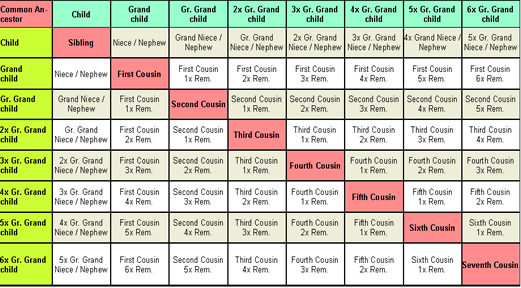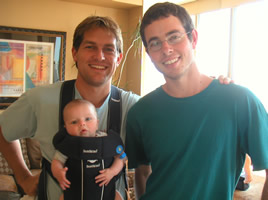RELATIONSHIP CHART
The chart below is based on the system used by courts and most genealogical societies.

Abbreviations: Gr=“Great” and Rem. = “Removed”
To identify the relationship between any two relatives, first identify their common ancestor. Determine the column that shows the relationship to the common ancestor. Then determine the row that shows the relationship between the other relative and the common ancestor. The intersection of the column and row shows the relationship between the two.
For example, if you are the great-grandchild of the common ancestor and the other person is also a great-grandchild, you are second cousins. As a second example, if you are the grandchild of the common ancestor and the other person is the great-grandchild, you are first cousins one generation removed, or, once removed.
When the word "removed" is used to describe a relationship, it indicates that the two people are from different generations. The words "once removed" mean that there is a difference of one generation, twice removed means that there is a two-generation difference.

Here's a real example. David Fine, Lior Sheffer and Caiden Fine (above) met in New York in 2005. Lior was visiting from Israel and David and Caiden were visiting from Albuquerque, NM. They share a common ancestor as David and Lior are both great-great-great grandsons of Henach Safer. David's great-great grandfather, Yitzchak-Isaac Safer and Lior's great-great grandmother, Peshe Safer, were brother and sister. That makes David and Lior fourth cousins and Caiden and Lior fourth cousins once-removed.
*******************************************************************************
Having trouble coming up with the proper term for your mother's uncle's father? Here's a guide to who's who in the family structure:
Uncle and aunt - They are your parents' brothers and sisters and their spouses. You don't need any blood connection to be a full-fledged aunt or uncle. Your mother's sister's husband is not your uncle by marriage. He's your uncle, fair and square.
Niece and nephew - They are the son and daughter of your siblings and siblings-in-law. As with your uncle and aunt, they're not your nieces and nephews by marriage, they're your nieces and nephews, plain and simple, even if they're your spouse's siblings' kids and don't have a single drop of blood in common with you.
First cousin, full cousin - They are the children of your parents' brothers and sisters. You and your first cousins share one set of grandparents.
Double first cousins - If a pair of brothers marries a pair of sisters, their kids are not only first cousins, they're double first cousins. They have both sets of grandparents in common.
Second cousins - You and the children of your parents' cousins are second cousins and share at least one great-grandparent. Your child and your cousin's child are second cousins.
Third cousins - You and the children of your parents' second cousins are third cousins and share at least one great-great-grandparent, and so on with the fourth, fifth, and sixth cousins.
First cousin once removed - A relationship that is removed crosses two genealogical generations. Generation refers to the order of birth, a genealogical level. Your aunt and your mother may have been born 20 years apart, but they are still of the same generation. Your parent's first cousin is your first cousin once removed. The child of your first cousin is also your first cousin once removed. Your grandparent is that child's great-grandparent. You can do the whole "removed" thing for every category of cousins -- second cousin once removed, and so on. But by then you'll probably drive everyone completely crazy.
Great or Grandaunt and granduncle - We always called grandpa's sister "great-aunt." But the experts say that terminology is incorrect. The term "grand" should be used instead to refer to the siblings of your grandparents.
In-laws - They are your family by marriage. Your spouse's parents, spouses of your siblings, and spouses of your spouse's siblings. That is, your brother's wife is an in-law, but none of her siblings are. And your husband's sister's husband is your in-law, but none of his brothers are. And in-laws pretty much stop with your parents-in-law and your siblings-in-law. You are not in-laws with the parents of your sister-in-law's husband. And the two sets of parents of a couple are not in-laws to each other either; they are the competitive parents, an entirely different category.
Affinity relatives - They are your spouse's blood relatives, that is, the in-laws that are biologically related to your spouse.
Birth mother, biological mother, natural mother - Terms for the biological mother of a child who has (usually) been adopted by other parents.
Adoptive mother/father - Mother/father of a child who is not biologically her/his own.
DISCLAIMER: THIS IS WORK IN PROGRESS. WE ARE NOT SURE THIS INFORMATION IS ENTIRELY CORRECT, AND WE KNOW IT IS INCOMPLETE. |